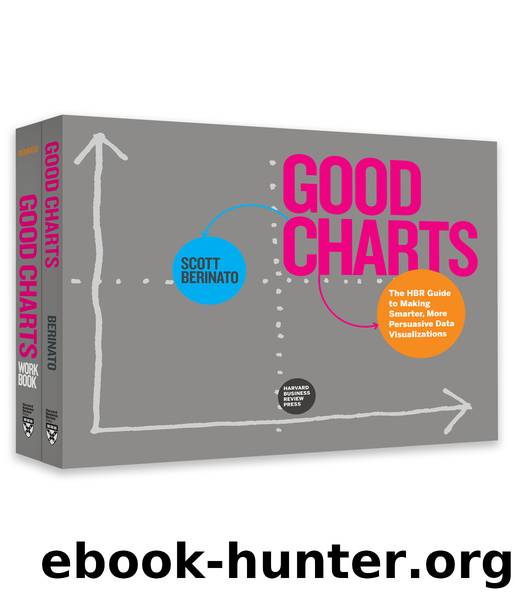The Harvard Business Review Good Charts Collection by Berinato Scott;Berinato Scott.;

Author:Berinato, Scott;Berinato, Scott.; [Berinato, Scott]
Language: eng
Format: epub
ISBN: 9781633697300
Publisher: Lightning Source Inc. (Tier 2)
Published: 2019-02-19T00:00:00+00:00
CONCLUSION
KEEP GOING
IN SOME WAYS, data visualization is a terrible term. It reduces the idea of good charts to a mechanical procedure. It evokes the tools and methodology required to create rather than the creation itself. It’s like calling Moby-Dick a “word sequentialization” or Starry Night a “pigment distribution.”
It also reflects an ongoing obsession in the dataviz world with process over outcomes. Even now, most of the energy poured into teaching dataviz focuses on making sure you do it the “right” way or judging you if you do it the “wrong” way; on picking the right form; on when to use what colors. Chart crit is all about technique, how the thing was built, what it looks like.
Enough of all that. Forget right charts and wrong charts. Data is only a middleman between phenomena and your ideas about them.1 And visualization is merely a procedure, a way of using that middleman to communicate ideas that convey much more than just pictures of statistics. What we do, really, when we make good charts is get at some truth and move people to feel that truth: To see what couldn’t be seen before. To change minds. To cause action. It’s not data visualization so much as visual rhetoric: the art of graphical discourse.
A common understanding of some basic grammar is necessary to that, of course. We all need to use subjects and verbs in roughly the same way if we’re to communicate. But letting them govern our communication would be paralyzing and counter-productive. When you obsess on the minutiae of visualization rules—or, worse, when you judge a chart according to its relative adherence to those rules—you become one of Emerson’s little statesmen, adoring foolish consistencies.
Besides, software is beginning to take care of all that for you. Tools are evolving to manage some of the grammar.2 They’re getting their own versions of document templates, spell check, and grammar check to guide formatting decisions and correct common missteps. Decisions about color, labels, grid lines, even what chart type to use—decisions to which entire books and courses have been devoted—are being encoded into visualization software so that the output in its default state is at least pretty good.
Interactivity helps too. The number and type of labels to include in a visualization, for example, is a decision that we’re used to making as we construct charts, and it can be difficult. Too many labels create clutter, making it hard to know where to focus; not enough confuse viewers and, likewise, make choosing the proper focus a challenge. But hover states help solve the problem. Toggles manage complexity by showing or hiding variables as needed. A simple Next button can control the pace at which information is added or removed from a visualization.
If you want a peek at the future of data visualization—at least, the mechanical process of it—look at The Atlas of Economic Complexity, an interactive site codeveloped by Harvard and MIT and managed by Harvard’s Center for International Development.3 Shown here is a tree map generated by the site.
Download
This site does not store any files on its server. We only index and link to content provided by other sites. Please contact the content providers to delete copyright contents if any and email us, we'll remove relevant links or contents immediately.
Hit Refresh by Satya Nadella(8929)
The Compound Effect by Darren Hardy(8642)
Change Your Questions, Change Your Life by Marilee Adams(7485)
Nudge - Improving Decisions about Health, Wealth, and Happiness by Thaler Sunstein(7368)
The Black Swan by Nassim Nicholas Taleb(6858)
Deep Work by Cal Newport(6712)
Daring Greatly by Brene Brown(6301)
Rich Dad Poor Dad by Robert T. Kiyosaki(6259)
Principles: Life and Work by Ray Dalio(6059)
Man-made Catastrophes and Risk Information Concealment by Dmitry Chernov & Didier Sornette(5778)
Playing to Win_ How Strategy Really Works by A.G. Lafley & Roger L. Martin(5654)
Digital Minimalism by Cal Newport;(5498)
Big Magic: Creative Living Beyond Fear by Elizabeth Gilbert(5476)
The Myth of the Strong Leader by Archie Brown(5310)
The Slight Edge by Jeff Olson(5265)
Discipline Equals Freedom by Jocko Willink(5200)
The Motivation Myth by Jeff Haden(5069)
Stone's Rules by Roger Stone(4939)
The Laws of Human Nature by Robert Greene(4868)
